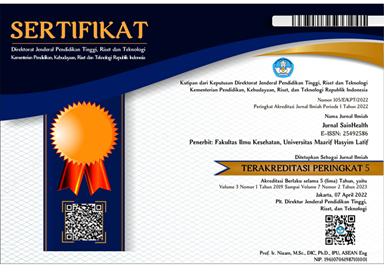PENENTUAN DOSIS KAPORIT SEBAGAI DESINFEKTAN DALAM MENYISIHKAN KONSENTRASI AMMONIUM PADA AIR KOLAM RENANG
DOI:
https://doi.org/10.51804/jsh.v1i2.106.66-74Keywords:
Disinfectant, calcium hypochlorite, BPC, Removal of AmmoniumAbstract
Disinfectant commonly used in water swimming pools is calcium hypochlorite {Ca(OCl) 2 }. Calcium hypochlorite is disinfectant which is used in the cleaning of water due to a searchable, inexpensive and contain approximately 70% chlorine. The use of calcium hypochlorite with improper doses will cause the formation of trihalomethane (THMs) compounds which are toxic and carcinogenic nature so that the use of calcium hypochlorite should be based on the calculation of Break Point Clorination (BPC) in order to secure for the environment. The purpose of the research was determine the opyimum dose of calcium hypochlorite in the form of crystal and solution for removal concentration of ammonium. The results obtained from the research that the optimum dose in the water swimming pools for disinfection process is not more than 10 g/L. The addition of calcium hypochlorite in the form of crystals can be removal the concentration of ammonium of 87.50% and in the form of aqueous solution of 83.30%. so it can be deduced that the addition of calcium hypochlorite in the form of crystals better than as a solution to removal the concentration of ammonium.References
Ali, M., 2010. Peran Proses Desinfeksi dalam Upaya Peningkatan Kualitas Produk Air Bersih. Universitas Pembangunan Veteran Nasional, Surabaya.
Cita, Dian Wahyu dan Adriyani, Retno., 2013. Kualitas Air dan Keluhan Kesehatan Pengguna Kolam Renang di Sidoarjo. Journal Kesling Vol.7 No.1 Juli 2013.
Clesceri, L.S., Greenberg, A.E., Eaton, A.D, 1998. Standard Methods for the Examination of Water and Wastewater. American Public Health Association. Washington DC.
Joko. T. 2010. Unit Produksi Sistem Penyediaan Air Minum. Graha Ilmu, Yogyakarta.
Lestari, D.E., Utomo, S.B., Sunarko, Virkyanov, 2008. Pengaruh Penambahan Biosida Pengoksidasi Terhadap Kandungan Klorin untuk Pengendalian Pertumbuhan Mikroorganisme pada Air Pendingin Sekunder RSG-GAS. Pusat Reaktor Serba Guna-BATAN. Kawasan Puspitek Serpong. Tangerang. Banten.
Said, N.I., 2007. Desinfeksi untuk Proses Pengolahan Air Minum. Jurnal Air Indonesia, 3(1):15-20.
Santika, S.S., Alaerts, G. 1984 . Metoda Penelitian Air. Usaha Nasional. Surabaya Sawyer, C.N., McCarty, P.L., Parkin, G.F. 1994 . Chemistry for Enviromental Engineering and Science. McGraw-Hill. New York
Setiono, L., Pudjaatmaka, A.H. 1997. Buku Ajar Vogel KImia Analisis Kuantitatif Anorganik. EGC. Jakarta.
Sururi, R. M., Rachmawati, S.Dj., Sholichah, M.,. 2008. Perbandingan Efektifitas Klor dan Ozon sebagai Desinfektan pada Sampel Air dari Unit Filtrasi Instalasi PDAM Kota Bandung. Prosiding Seminar Nasional Sains dan Teknologi-II 2008 Universitas Lampung.
Rosyidi, M.B., 2010. Pengaruh Breakpoint Chlorination (BPC) terhadap Jumlah Bakteri Koliform dari Limbah Cair Rumah Sakit Umum Sidoarjo. Institut Teknologi Surabaya, Surabaya.
Tchobanoglous, G., Burton, F.L. 1991. Wastewater Engineering Treatment Disposal Reuse. McGraw-Hill. New York
Downloads
Published
Issue
Section
License
Jurnal SainHealth is licensed under Creative Commons Attribution 4.0 International License.
Under the following terms:
Attribution — You must give appropriate credit, provide a link to the license, and indicate if changes were made. You may do so in any reasonable manner, but not in any way that suggests the licensor endorses you or your use.
No additional restrictions — You may not apply legal terms or technological measures that legally restrict others from doing anything the license permits.
















